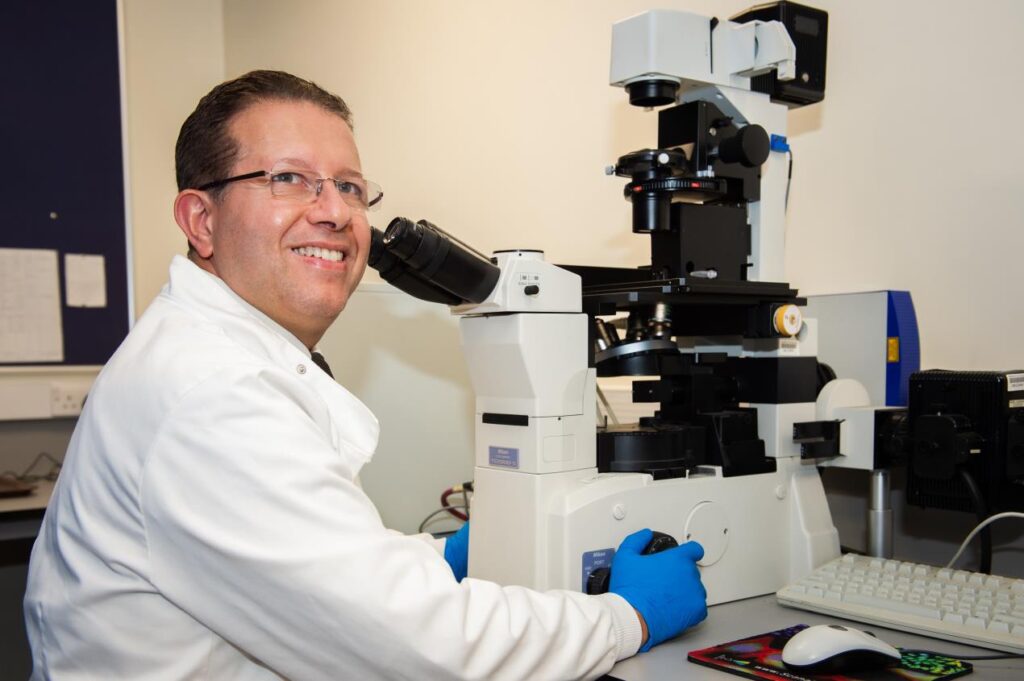‘Junk DNA’ gives up healing secrets

Scientists at the University of Bradford (England) have made a major breakthrough in the understanding of how DNA repairs itself.
Professor Sherif El-Khamisy’s findings are published in the leading scientific journal Nature, which publishes the finest peer-reviewed research in all fields of science and technology.
The discovery was made after Professor El-Khamiy, who is Director of the Institute of Cancer Therapeutics, and his team were examining proteins in the cerebellum – the part of the brain responsible for motor function – when they encountered something extraordinary.
Professor El-Khamisy explained: “Unlike other tissues in the body, most cells in the brain do not reproduce, which means when you lose them, they are gone forever. However, when we were looking at cells in the cerebellum, we found a high concentration of the nuclear mitotic apparatus protein (NuMA), which is primarily responsible for cell division. So, our first question was, why is this NuMA protein so abundant here if there is no cell division?”
Trash and treasure
Even more surprising was that the discovery was made in part of our DNA which up until recently has been considered by scientists as ‘junk’.
DNA has parts which ‘code’, or create proteins, and parts which do not. The parts which do the coding comprise only two per cent of our DNA, the majority of the rest of our DNA is not involved in coding, and for a long time scientists thought this was ‘junk’, and that perhaps it was just there to protect the two per cent that does the coding.
More recently it has been realised that this ‘junk’ DNA plays an important role in regulating the coding regions. It determines what time, how much, and in which tissues the proteins are produced, and that has important implications because if this regulation is not done properly, it means we can have either too much or too little of a given protein and it is this which leads to disease.
DNA ‘breaks’
DNA is constantly subjected to wear and tear via a process known as oxidative genome damage. This is primarily caused by our own metabolisms but can also be caused by other things such as pollutants. During the time you have been reading this article, for example, the DNA inside your cells will have suffered hundreds of ‘DNA breaks’ simply as a result of the chemical processes that take place inside your cells to keep them alive.
Professor El-Khamisy said they had now discovered that these DNA breaks are not confined to the coding regions but also occur in the ‘junk’ DNA, and that if they are not fixed, that has a direct impact on the regions which code proteins.
“We have known for some time about breaks in the DNA coding regions and also about the repair mechanisms. What we have found in this work is that those breaks also occur in the ‘junk’ DNA, and what is interesting about that is that the repair of those breaks plays a very important role in the production of the proteins from the coding regions.
“Additionally, we have discovered how this process is done, by finding the key players so-to-speak, one of which is the NuMa protein. We already knew it played an important role in putting chromosomes together when cells divide but no-one could have imagined it plays a very different – but equally important – role in fixing DNA breaks in the non-coding regions.”
It is hoped the discovery will lead to new research that could result in the development of improved diagnosis and treatment for a variety of conditions. Professor El-Khamisy added: “When we began our study, this was not something we went looking for, so in a way we stumbled into it. This will open new fields of investigation into diagnostic and therapeutic treatments. We often as humans look at the obvious and ignore the less obvious. From that perspective, this is certainly something that has been missed, but now found.
Prof El-Khamisy added: “I suspect a lot of work will follow on from this. Scientists will want to know what these breaks in the non-coding regions are doing and how their repair impact other processes in the cell. For example, we don’t yet know whether mutations of NuMA could be linked with cancer, or dementia, or motor neurone disease.
“The exciting thing about DNA is that every time we think we understand it, that we have solved the puzzle, a new puzzle presents itself. The next challenge is to look at what diseases and conditions might be linked to this discovery, and how we exploit components of this new pathway to develop new therapeutics and disease biomarkers”
This work is led by Professor Sherif El-Khamisy and his team and collaborators at the Universities of Bradford and Sheffield.
DNA fact file
· The human genome contains 3 billion base pairs of DNA and if you stretched it out end to end it would reach from the earth to the sun and back… 600 times
· DNA is an abbreviation for deoxyribonucleic acid
· Even though DNA codes all the information that makes up an organism, it is made up of just four building blocks, the nucleotides: adenine, guanine, thymine, and cytosine
· DNA breaks occur constantly throughout our lives, mainly as a result of cellular metabolism – this results in thousands of DNA breaks every single day, but most of them are repaired
· Outside the body, DNA can remain stable for hundreds of millions of years, because it is no longer subjected to the constant chemical wear and tear caused by chemical energy use





